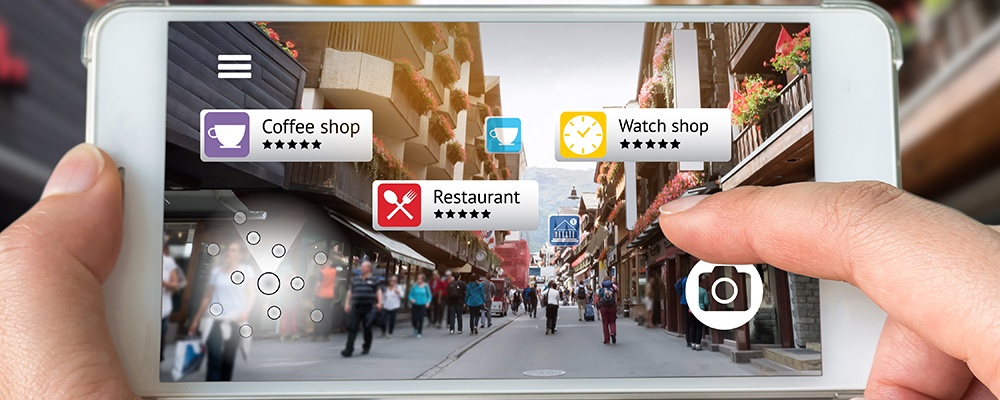Why Augmented Reality will fundamentally change the way your customers shop
A picture tells a thousand words, and according to Gartner, 74% of people are most likely to engage with an e-commerce website that uses photos. What if pictures could be projected into the real world and brought to life in 3D? This is Augmented Reality (AR), where consumers can engage and interact in the real world.
So, what is AR and how is it different to Virtual Reality (VR)? Often the terms VR and AR get lost in translation but, it is important to understand the difference. VR is an entirely immersive technology that uses hardware to take us into a completely computer-generated environment. AR, on the other hand, uses devices or wearables to add a digital layer to our surrounding environment, essentially creating an extension of the real world through computer enhancement.
With two exciting emerging technologies available to consumers, which way do businesses need to be looking to invest and grow? Tim Cook, the CEO of Apple, has made his support of AR over VR clear, suggesting it would be the “larger of the two, probably by far.” Cook argues that AR gives businesses the capability to be physically present and visually active, whereas VR encloses and immerses the individual into an experience which will probably have a lower commercial interest over time.
As AR is becoming more widely understood it has become a key area for business success by many industries and as such businesses are investing accordingly. Market and Markets predicts the AR industry will produce $117.80 billion in revenue by 2020. Not only will the consumers of this technology be investing, but software giants such as Microsoft and Apple are deep in development on their own AR specific hardware to bring to the market. In fact, Microsoft released the developer version of its HoloLens headset in early 2016. It has since been used for numerous experimental projects, including London Fashion Week where attendees could see the full 2017 collection come to life in the form of holograms.
Given the investment interest and emerging tools for AR experience, it’s important for retailers to understand how AR can benefit their business. Like all new technologies, it is important to understand the problems that it can solve and the benefits it can provide to end users. By using 3D and interactive components, AR applications are limitless. One of the primary benefits being harnessed by the retail industry is the ability to enable consumers to make more informed decisions about their purchases. This has been shown to reduce product returns, as well as engage consumers in new products before their release. In the early stages of the technology, it also can provide an engaging point of difference for marketing. But with Gartner expecting 100 million people shopping with AR by 2020, this technology is moving fast, and retailers need to be prepared.
A full view of the product
AR can merge a variety of digital product collateral such as images, models, videos and sound and represent them in new ways for a consumer to engage with in the real world. With 81% of consumers already making their purchasing decisions via the web (Gartner), AR helps provide even more information to customers to help with decision-making. By producing a digital 3D replica in a real-life environment, customers are able to view products from all angles in the context of their own environment. Eventually creating 3D assets for this purpose will be considered a standard process, like taking product images for e-commerce.
IKEA has been a pioneer in AR for product visualisation, using it to transform their popular catalogue by projecting their products into the homes of their customers. Customers can then use the IKEA AR app to view their choice of furniture through the app and in their home using Apple’s ARKit.
We are already seeing businesses of all sizes adopting the technology and securing sales through it. Plattar’s recent work with major hotel chain, Escape to Paradise, is a great example of the impact augmentation can have in the real world. In the first month, Escape to Paradise has seen a 300% return on investment (ROI) through its branded Plattar AR application.
Reducing returns through augmentation.
Another retailer using AR to improve customer satisfaction is fashion designer Rebecca Minkoff and co-founder Uri Minkoff who partnered with a startup to help consumers connect with their brand. This AR App, Zeekit, allows consumers to upload a photo of themselves and pick out clothing items. Zeekit then enables consumers to overlay these items on their body using the size they select. According to Minikoff, the current industry standard for returns is 20-40%, and she believes Zeekit can help minimise product returns by more accurately predicting which size dress or pants look best on each individual.
For IKEA, the issue of returns is even more significant. When consumers are armed with precise measurements, trying to imagine exactly how a beautiful new sofa will look in their living room is not an easy task. It will, therefore, come as no surprise that IKEA have found that 14% of their customers end up taking home furniture which turns out to be the wrong size for its intended location. Thanks to AR this number of returns is being reduced.
Future technologies
As 3D models and AR become the retail norm, there is a strong interest in the next step in this space to keep ahead of the competition.
A new AR technology to look out for is the Structure Sensor, which is a compact 3D sensor designed to attach to a tablet. This technology can capture a 3D model of a living room or any other object. Think of the way we share 3D spaces with someone today, but instead of photos or videos, it quickly creates a 3D model. It allows products to be precisely positioned and viewed in real world environments while also simplifying the creation of high-fidelity 3D models with high-resolution.
The bottom line
Despite all of the new technology and interest surrounding AR, it is important not to rush the development of an AR app whose sole merit is the fact that it sports AR technology. Quality implementation of AR must come first, it should serve to enhance existing ideas, not to stand alone by itself. Retailers need to understand and implement AR to enhance the customer experience. With some top brands already embracing this new technology, it’s safe to say that AR has secured its place in the retail marketplace.






















